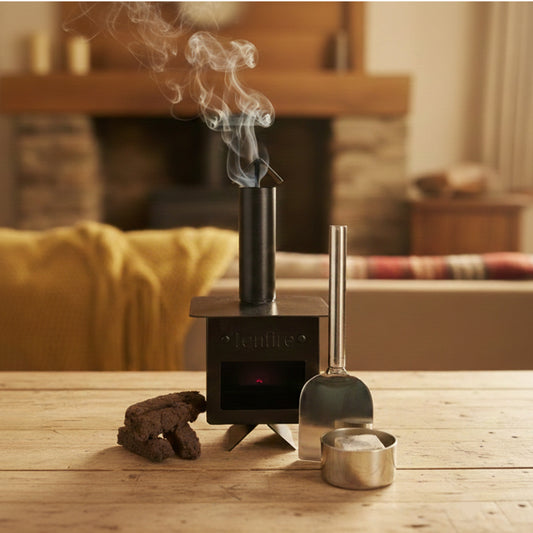
What Types Of Candles Are Safe To Burn?
By Dawn, Founder of Tenfire
Not all candles are created equal. Some burn cleanly, safely, and beautifully—while others fill your home with soot, irritants, or chemicals you’d rather not inhale.
If you're wondering, “What candles are safe to burn?”, you’re not alone. As the founder of Tenfire, I've tested hundreds of candles over the years—and I’ve seen what makes one safe, and another questionable.
This guide will break it down clearly: the wax, the wick, the fragrance, and how you burn it—all of it matters.
TL;DR – What Candles Are Safe to Burn?
- Choose natural waxes: soy, beeswax, coconut
- Look for cotton or wooden wicks, not metal-core
- Prefer phthalate-free or transparent fragrance oils
- Burn with care: short sessions, trimmed wick, no draughts
- Avoid candles with no label or ingredient info
Why Candle Safety Matters
Burning a candle seems simple—but it’s still fire, fuel, and scent chemistry. A poorly made candle can:
- Release black soot into the air
- Irritate eyes or lungs
- Leave oily residue on walls
- Aggravate asthma or sensitivities
A safe candle, on the other hand, enhances your space without adding worry.
Natural vs. Synthetic Wax: What to Know
The type of wax your candle uses matters. It’s the main ingredient, and it’s what burns for hours in your space.
Safer waxes:
- Soy wax – clean-burning, renewable, low soot
- Beeswax – natural, non-toxic, air-purifying
- Coconut wax – creamy, slow-burning, low soot
Less safe:
- Paraffin wax – a petroleum by-product that can release VOCs and black soot when burned
If the label doesn’t say what wax it uses—be cautious.
Why We Avoid Paraffin Wax
Paraffin is cheap, holds scent well, and has been used in candles for decades. But it’s also made from crude oil refining—and when burned, it can release:
- Toluene and benzene (potential carcinogens)
- Fine black soot
- Irritants that can affect sensitive lungs
While occasional use isn’t the end of the world, daily exposure—especially in closed spaces—isn’t ideal.
Bottom line: Paraffin isn’t the cleanest option. If you care about indoor air quality, skip it.
Best Wax Options for Safe Candles

- Soy Wax – Sustainable, slow-burning, and biodegradable. It’s what we use at Tenfire.
- Beeswax – Natural and hypoallergenic. It has a subtle honey scent and burns with a bright, clean flame.
- Coconut Wax – Less common, but beautifully slow-burning and clean. Often blended with soy.
These waxes offer clean melts and pair well with high-quality fragrance oils.
What to Know About Candle Wicks

Wicks are small, but they play a big role in safety. They affect flame size, heat output, and what you breathe.
Safe wick options:
- Cotton wicks (flat or braided)
- Wooden wicks (crackling and clean-burning)
Wicks should be lead-free and uncoated—or coated in natural wax only.
The Problem with Metal-Core Wicks
Metal-core wicks were once common, used to keep wicks upright. But:
- Lead wicks were banned in the U.S. in 2003
- Cheaper or imported candles may still use them
- Burning lead can release toxins into the air
If the wick looks like it has a wire in the middle—avoid it. Most safe candles will say “lead-free” or list the wick type clearly.
Fragrance Oils: Clean vs. Chemical
Scent is the soul of a candle. But not all fragrance oils are safe.
Cleaner fragrance choices:
- Phthalate-free blends
- Essential oil blends (watch for sensitivities)
- Tested, IFRA-compliant oils
Risky options:
- Low-cost synthetic oils
- Overly strong fragrances (often loaded with unlisted ingredients)
Strong doesn’t always mean better. Subtle, layered, and clean-smelling often means safer.
Phthalates in Fragrance: Should You Worry?
Phthalates help scent linger. But some types have been linked to hormonal disruption, headaches, and allergic reactions.
At Tenfire:
- All of our oils are IFRA compliant
- Many of our scents are phthalate-free
- Some contain trace amounts for performance (always listed)
- We test all oils for safe use in small spaces
We’re transparent so you can make the call that’s right for your home.
How Tenfire Approaches Candle Safety

Here’s what we commit to in every Tenfire candle:
- 100% soy wax, sustainably sourced
- Cotton wicks, always lead-free
- Carefully selected, high-performance fragrance oils
- Tins and vessels tested for heat stability
- No dyes, glitter, or unnecessary additives
How to Burn Candles Safely at Home
- Trim wick to 5mm before lighting
- Keep away from draughts (flame should be steady)
- Burn on a flat, heat-resistant surface
- Limit sessions to 3–4 hours
- Let wax reset fully between burns
- Never leave unattended, especially near pets or kids
Burning safely also extends your candle’s life.
What to Avoid When Buying Candles
Watch for these red flags:
- No wax type listed
- No wick type mentioned
- “Fragrance” listed with no details
- Strong chemical smell before lighting
- Oversized flames or lots of smoke when lit
- Plastic or untreated wood containers
If it feels cheap or smells off—it probably is.
Final Thoughts from Dawn
So—what candles are safe to burn? The ones made with intention.
When you choose a natural wax, a clean wick, and a tested fragrance, you can enjoy candlelight without worry.
At Tenfire, we don’t just care about how our candles smell—we care about how they make you feel. Safe. Calm. At home.
If you ever have questions about ingredients, fragrance, or burn tips, we’re always here.
Here’s to clean candles and cleaner air,
Dawn
Founder, Tenfire





